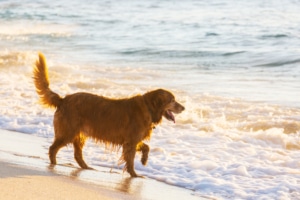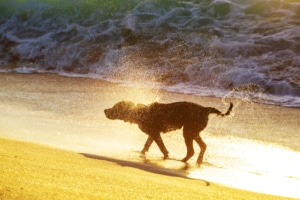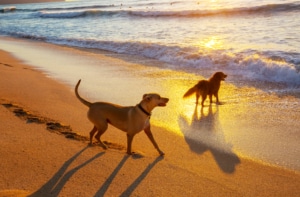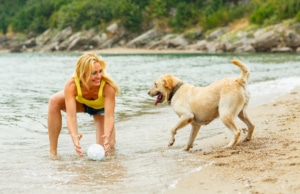Beaches that allow pets. (Animals must be on leashes):
Bay Front Park. U.S. 41 and Ringling. Next to Marina Jack Restaurant. (Some water)
Bird Key Park on the John Ringling Causeway. (Beachfront)
Ken Thompson Park – 1700 Ken Thompson Parkway. On City Island, by Mote Marine Lab. (Beachfront)

1. Keep Them Cool to Avoid Heatstroke
To keep your dog safe, avoid the dog beach at the hottest parts of the day, and provide your pup with plenty of access to shade and fresh, cool water.
If your dog seems overly tired or is panting more than normal, it’s a good idea to wrap up the day early and get them into the air conditioning, says Dr. Fort.
But if your dog is exhibiting symptoms like extreme lethargy, excessive panting, red (rather than pink) mucous membranes, diarrhea, and vomiting, bring them to a vet immediately. Those could be signs that the dog is suffering from extreme heat stress.

2. Don’t Let Them Drink Saltwater
Drinking salty seawater could dehydrate your dog, says Dr. Fort. Make sure to bring plenty of fresh, cool water and a portable dog water dish so your dog isn’t tempted to drink from the ocean.
Ingesting a small amount of seawater won’t do any harm as long as dogs have access to fresh water, but if they swallow enough seawater, they can become seriously dehydrated. Signs include vomiting; thick, ropy saliva; and dry, tacky gums. Dr. Fort recommends establishing what your dog’s saliva and gums look like under normal conditions so you can immediately recognize—and hopefully prevent—a potential problem at the dog beach.
If your dog is vomiting and having trouble walking, those could be signs of severe dehydration.
“Bring them to the vet immediately,” says Dr. Fort. Senior dogs, puppies, and those that have health problems could be especially predisposed to dehydration.

3. Keep Them Safe in the Water
Another pet safety item for your pre-beach to-do list is to “Let your dog practice her swimming skills in a controlled environment,” says Dr. Robert Trimble, co-founder and head of veterinary services at Fuzzy Pet Health in San Francisco.
Take a look at the tide charts—in some regions, the size of the waves can vary drastically based on the time of year—and avoid days when the currents are strong, says Dr. Trimble.
Consider putting even good swimmers in a flotation device, says Dr. Fort. A dog life jacket with a chin support flap and bright colors can help keep pups safe in the water. And always keep a close eye on your pup when she’s off-leash. “Never turn your back on the ocean,” says Dr. Trimble.

4. Get the Right Sun Protection
Dog sunscreen and wipes are specially formulated for dogs to protect your pup from the sun without exposing her to potentially harmful ingredients like zinc, which is often contained in sunscreen made for people.
Apply dog sunscreen to areas like the nose and ears, where the fur is thinner, says Dr. Fort. He recommends rubbing the dog sunscreen thoroughly and letting it dry before bringing your dog outside.
After your dog beach day, check your pup for signs of sunburn, including red and inflamed patches. While you’re checking your dog’s skin, you should also make sure their eyes weren’t irritated by the sun or sand.

5. Protect Your Pups From Parasites
A day on the beach can expose your pet to harmful bacteria and parasites. The pools that form along the shore could be a breeding ground for bacteria that cause diseases like leptospirosis, which could lead to kidney failure, says Dr. Trimble. Don’t let your dog wade through or drink from stagnant pools of water.
There is a vaccine to help prevent leptospirosis. Consider talking to your veterinarian to see if it’s appropriate for your pup.
Staying up to date with dog flea and tick prevention also keeps your dogs safe if they have to walk through any woods or vegetation on their way to the dog beach. And don’t forget their heartworm medicine!
Cited: PetMD.com and SCGOV.net





